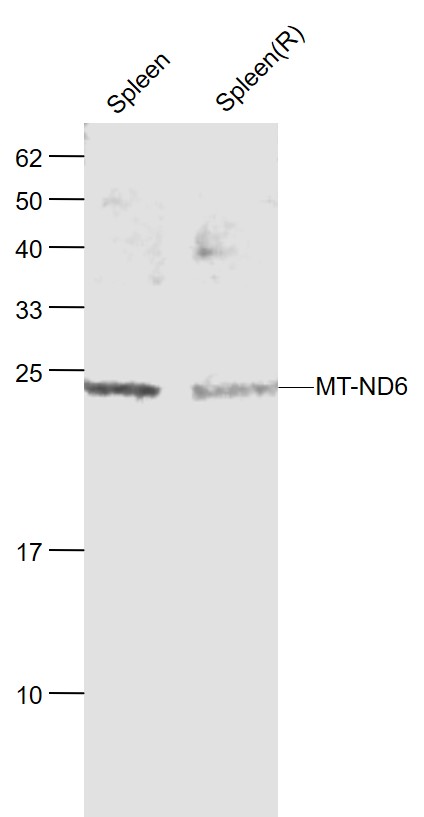
Rabbit Anti-MT-ND6 antibody
Mitochondrially encoded NADH dehydrogenase 6; NADH-ubiquinone oxidoreductase chain 6; MT ND6; mtND6; NADH dehydrogenase subunit 6 (complex I); NADH dehydrogenase subunit 6; NADH ubiquinone oxidoreductase chain 6; NADH Ubiquinone Oxidoreductase subunit ND6
View History [Clear]
Details
Product Name MT-ND6 Chinese Name NADH复合体6抗体 Alias Mitochondrially encoded NADH dehydrogenase 6; NADH-ubiquinone oxidoreductase chain 6; MT ND6; mtND6; NADH dehydrogenase subunit 6 (complex I); NADH dehydrogenase subunit 6; NADH ubiquinone oxidoreductase chain 6; NADH Ubiquinone Oxidoreductase subunit ND6; NADH6; ND6; NU6M_HUMAN; NU6M_HUMA Research Area Tumour Cell biology immunology Neurobiology transcriptional regulatory factor Immunogen Species Rabbit Clonality Polyclonal React Species Mouse, Rat, (predicted: Rabbit, ) Applications WB=1:500-2000
not yet tested in other applications.
optimal dilutions/concentrations should be determined by the end user.Theoretical molecular weight 19kDa Cellular localization cytoplasmic Form Liquid Concentration 1mg/ml immunogen KLH conjugated synthetic peptide derived from mouse MT-ND6: 31-130/172 Lsotype IgG Purification affinity purified by Protein A Buffer Solution 0.01M TBS(pH7.4) with 1% BSA, 0.03% Proclin300 and 50% Glycerol. Storage Shipped at 4℃. Store at -20 °C for one year. Avoid repeated freeze/thaw cycles. Attention This product as supplied is intended for research use only, not for use in human, therapeutic or diagnostic applications. PubMed PubMed Product Detail NADH Dehydrogenase subunit 6 (MTND6) is 1 of the 7 mitochondrial DNA (mtDNA) encoded subunits (MTND1, MTND2, MTND3, MTND4L, MTND4, MTND5, MTND6) included among the approximately 41 polypeptides of respiratory Complex I. Complex I accepts electrons from NADH, transfers them to ubiquinone (Coenzyme Q10), and uses the energy released to pump protons across the mitochondria inner membrane. MTND6 has been proposed to be a component of the iron-protein fragment.
Function:
Core subunit of the mitochondrial membrane respiratory chain NADH dehydrogenase (Complex I) that is believed to belong to the minimal assembly required for catalysis. Complex I functions in the transfer of electrons from NADH to the respiratory chain. The immediate electron acceptor for the enzyme is believed to be ubiquinone (By similarity).
Subcellular Location:
Mitochondrion membrane; Multi-pass membrane protein (Potential).
DISEASE:
Defects in MT-ND6 are a cause of Leber hereditary optic neuropathy (LHON) [MIM:535000]. LHON is a maternally inherited disease resulting in acute or subacute loss of central vision, due to optic nerve dysfunction. Cardiac conduction defects and neurological defects have also been described in some patients. LHON results from primary mitochondrial DNA mutations affecting the respiratory chain complexes.
Defects in MT-ND6 are a cause of Leber hereditary optic neuropathy with dystonia (LDYT) [MIM:500001]; also called familial dystonia with visual failure and striatal lucencies. LDYT is part of a spectrum of Leber hereditary optic neuropathy. It is characterized by the association of optic atrophy and central vision loss with dystonia.
Defects in MT-ND6 are a cause of mitochondrial encephalomyopathy with lactic acidosis and stroke-like episodes syndrome (MELAS) [MIM:540000]. MELAS is a genetically heterogenious disorder, characterized by episodic vomiting, seizures, and recurrent cerebral insults resembling strokes and causing hemiparesis, hemianopsia, or cortical blindness.
Defects in MT-ND6 are a cause of mitochondrial complex I deficiency (MT-C1D) [MIM:252010]. A disorder of the mitochondrial respiratory chain that causes a wide range of clinical manifestations from lethal neonatal disease to adult-onset neurodegenerative disorders. Phenotypes include macrocephaly with progressive leukodystrophy, non-specific encephalopathy, cardiomyopathy, myopathy, liver disease, Leigh syndrome, Leber hereditary optic neuropathy, and some forms of Parkinson disease.
Similarity:
Belongs to the complex I subunit 6 family.
SWISS:
P03923
Gene ID:
4541
Database links:Entrez Gene: 4541 Human
Omim: 516006 Human
SwissProt: P03923 Human
Product Picture
References (0)
No References
Bought notes(bought amounts latest0)
No one bought this product
User Comment(Total0User Comment Num)
- No comment



 +86 571 56623320
+86 571 56623320
 +86 18668110335
+86 18668110335

